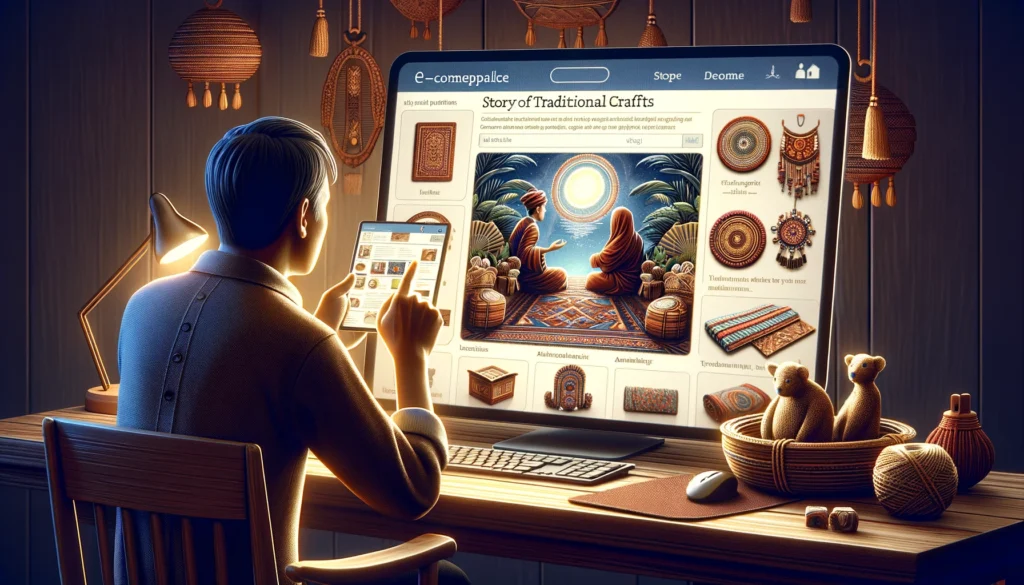In the tapestry of traditional crafts, the threads of creativity and culture are interwoven with the potential of digital technology. Today’s artisans are not just masters of their craft; they are savvy entrepreneurs leveraging e-commerce platforms to bring their creations to the global stage. This evolution marks a significant shift in how traditional crafts are marketed, sold, and preserved, ensuring their relevance in a digital world.
E-Commerce: A New Era for Artisans
The digital revolution has ushered in a transformative era for artisans around the world. E-commerce platforms have emerged as powerful conduits, connecting traditional craftsmanship with a global audience hungry for authenticity and meaning in the items they purchase. This new era is characterized not only by the expanded reach artisans now enjoy but also by the profound impact digital access has on the survival and flourishing of traditional crafts.

Bridging Worlds with Digital Marketplaces
E-commerce platforms act as bridges between the rich heritage of traditional crafts and the vast, digital marketplace. These platforms enable artisans to transcend geographical boundaries, making it possible for a woodcarver in rural India or a weaver in the Andes to sell their creations to customers in bustling cities thousands of miles away. This global storefront is revolutionary, providing artisans with unprecedented access to a worldwide audience.
Empowering Artisans Beyond Sales
Beyond merely selling products, e-commerce platforms empower artisans in several critical ways:
- Brand Building: Artisans can craft a compelling brand story around their creations, connecting with customers on a personal level. This storytelling is integral, transforming a simple transaction into an exchange of culture and values.
- Community Engagement: Platforms like Etsy and social media channels allow artisans to engage directly with their audience, receiving immediate feedback, fostering loyalty, and building a community of enthusiasts who are invested in their success.
- Skill Sharing and Collaboration: Digital marketplaces also serve as forums for artisans to share skills, collaborate on projects, and learn from each other, further enriching the craft community.

The Role of Social Media
Social media platforms have become indispensable tools for artisans in the e-commerce era. Instagram, with its visual focus, allows artisans to showcase the beauty and detail of their crafts, tell their stories through posts and stories, and even sell directly through integrated shopping features. Facebook and Pinterest offer additional avenues for reaching potential customers, sharing the inspirations behind their work, and driving traffic to their online shops.
Key Platforms Bridging the Gap
- Etsy: A household name for handmade and vintage items, Etsy provides artisans with a specialized platform to showcase their work, engage with customers, and grow their brand.
- Amazon Handmade: Amazon’s answer to Etsy, this platform combines the vast reach of Amazon with a commitment to handmade, authentic crafts, offering artisans a significant audience.
- Social Media: Platforms like Instagram and Facebook have transcended their original purposes, becoming vital tools for artisans to market their crafts. Through visual storytelling, live demonstrations, and direct engagement, artisans build a loyal following and drive sales.

Transforming Marketing and Sales
The advent of e-commerce platforms has not just opened new avenues for selling traditional crafts; it has fundamentally transformed the marketing and sales landscape for artisans worldwide. In this digital era, artisans are no longer confined to local markets or dependent on tourists for their livelihoods. Instead, they can showcase their work to a global audience, telling the unique stories behind each piece and connecting with customers on a personal level.
Digital marketing tools available through these platforms enable artisans to target their ideal customer base more effectively than ever before. SEO (Search Engine Optimization) strategies help their products appear in relevant searches, while social media marketing allows for the sharing of rich, engaging content that showcases the beauty and craftsmanship of their work. Analytics tools offer insights into customer behavior and preferences, enabling artisans to tailor their offerings and marketing strategies to meet the market’s demands.

Moreover, the shift towards online sales has democratized access to traditional crafts, allowing customers from all corners of the globe to discover and purchase unique handmade items they would otherwise never encounter. This global reach is transformative, not just for the artisans but for the preservation of traditional crafts themselves, ensuring they remain a vibrant and valued part of our global cultural heritage.
The Future of Craft in the Digital Marketplace
Looking ahead, the digital marketplace is poised to become an even more integral part of the ecosystem for traditional crafts. As technology continues to evolve, we can anticipate further innovations that will enhance the connection between artisans and consumers. Augmented reality (AR) could allow customers to visualize how a craft piece would look in their home before making a purchase, while virtual reality (VR) experiences could transport them to the artisan’s workshop, offering a deeper understanding and appreciation of the crafting process.
The future also holds potential for a more personalized and interactive shopping experience, with AI-driven recommendations helping customers discover crafts that match their tastes and interests. For artisans, advancements in e-commerce technology will streamline the logistical aspects of online selling, from inventory management to shipping, allowing them to focus more on their craft and less on the complexities of digital commerce.

As we move forward, the digital marketplace will continue to play a pivotal role in ensuring the survival and relevance of traditional crafts. It offers a sustainable model for artisans to thrive in a global economy, bridging the gap between the rich heritage of the past and the boundless possibilities of the future. By embracing these digital platforms, artisans ensure that their crafts—each a story, a tradition, a piece of cultural identity—are preserved, celebrated, and passed on for generations to come.
Author’s Note
The journey of traditional crafts from local markets to the global stage through digital marketplaces is a testament to the resilience and adaptability of artisans worldwide. This blog series celebrates their journey, exploring how technology serves not just as a tool for preservation but as a catalyst for innovation and growth. As we continue to delve into the future of traditional crafts in the digital age, let’s remain committed to supporting the artisans who keep these precious traditions alive, one click at a time.
G.C., Ecosociosphere contributor.
References and Further Reading
- “Mastering E-Commerce: A Comprehensive Guide on How to Build an Online Shop for Your Handmade Business” – A guidebook for artisans looking to navigate the digital marketplace.
- “Social Media for Artists: How to Showcase Your Work” – Offers strategies for using social media to enhance the reach and impact of traditional crafts.
- Etsy’s Seller Handbook – A resource provided by Etsy, offering advice on everything from photography to SEO for artisans on the platform.
By embracing the digital marketplace, artisans are not just preserving traditional crafts; they are ensuring these ancient arts continue to inspire, connect, and enrich our lives in the modern world.





Comments
Your point of view caught my eye and was very interesting. Thanks. I have a question for you.
I don’t think the title of your article matches the content lol. Just kidding, mainly because I had some doubts after reading the article.
I don’t think the title of your article matches the content lol. Just kidding, mainly because I had some doubts after reading the article.
Your point of view caught my eye and was very interesting. Thanks. I have a question for you.
Thanks for sharing. I read many of your blog posts, cool, your blog is very good.
Your article helped me a lot, is there any more related content? Thanks! https://accounts.binance.com/pl/register?ref=YY80CKRN